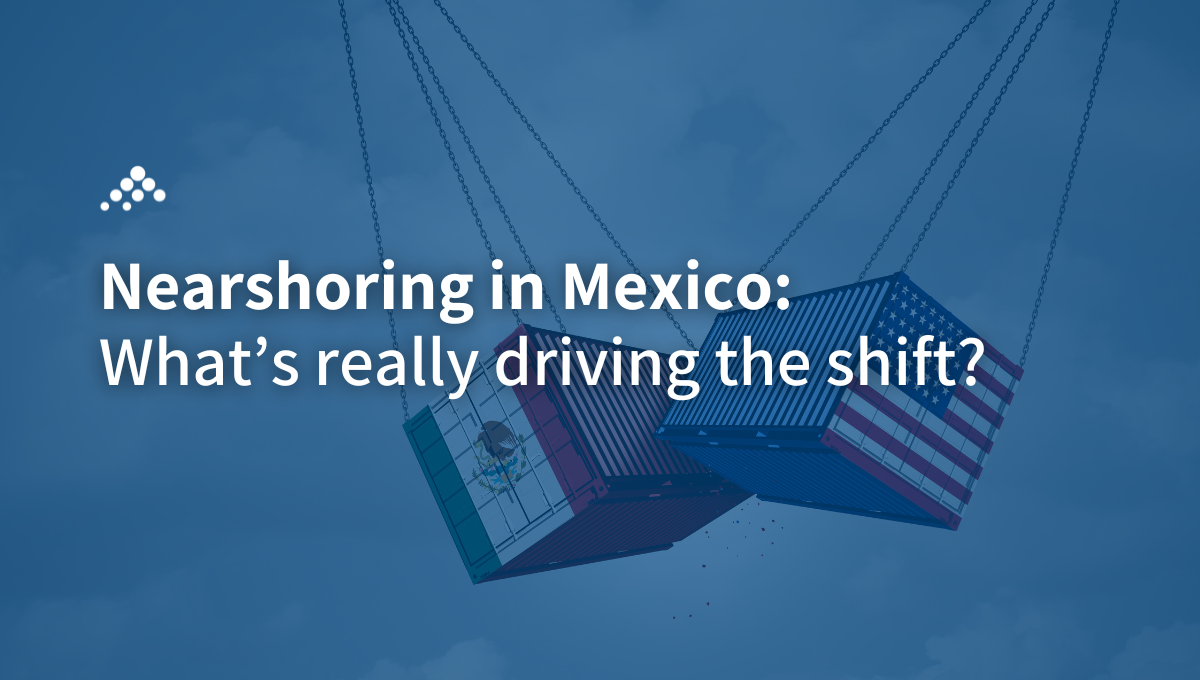- Brokerage & Managed Transportation
- Forwarding
- On-Demand
- Mexico
- Industries
- About Us
- Resources
- USA Jet
- Contact Us
Headquarters
info@ascentlogistics.com
+1 800.614.1348
2068 E Street
Belleville, MI 48111
- Brokerage & Managed Transportation
- Forwarding
- On-Demand
- Mexico
- Industries
- About Us
- Resources
- USA Jet
- Contact Us
Headquarters
info@ascentlogistics.com
+1 800.614.1348
2068 E Street
Belleville, MI 48111
Nearshoring in Mexico: What’s Really Driving the Shift?
08/07/2025

Supply chains look a lot different than they did just a few years ago. Shifting tariffs, rising costs and longer transit times continue to test operational limits. More companies are starting to ask the same question: Should we move production closer to home?
For many, the answer is Mexico.
Managing operations overseas makes it harder to get goods to North American markets quickly and cost-effectively. Nearshoring to Mexico shortens delivery times, reduces transportation costs and creates supply chains that can move in step with real-time demand.
In fact, U.S.–Mexico trade is stronger than ever. In 2024, trade between the two countries reached a record-breaking $840 billion, making Mexico the United States’ largest trading partner for the second year in a row.


What is nearshoring?
Nearshoring is the strategy of relocating operations, such as manufacturing, assembly or logistics, to a country closer to your end market.
For U.S.-based companies, that often means shifting production from Asia to Mexico. The goal is simple: shorten the distance between where products are made and where customers are located.
Unlike offshoring, where goods must cross oceans and time zones, nearshoring keeps operations within reach. The result is a faster, leaner supply chain that’s easier to manage. While not immune to disruption, nearshoring reduces many of the risks associated with global shipping.
Why are companies nearshoring in Mexico?
Supply chains are under pressure. Disruptions cost time and money, making flexibility a key competitive advantage. That’s why nearshoring in Mexico is gaining traction: it brings speed, control and reliability at a time when companies need all three.
Mexico’s proximity to the U.S. is a major advantage. Shipments from Mexico can reach North American markets in a matter of days instead of weeks. When demand shifts, production can adjust without getting caught in long transit routes or tied up at congested ports.
Time zone alignment helps, too. Teams can connect in real time, solve issues quickly and keep production running without late-night calls or delayed decisions.
Geography isn’t the only factor. Mexico also offers the right balance of talent and cost. Its workforce is highly skilled in complex manufacturing, especially in industries like automotive, aerospace and electronics. Combine that with affordable labor and quicker turnaround times, and the total landed cost often comes out ahead of offshoring alternatives.


More companies are taking notice. A 2024 industry survey found that 80% of chief operating officers plan to expand their use nearshoring for their supply chains over the next three years, up from 63% in 2022. Cross-border freight volumes continue to climb in 2025, showing growing confidence in the region.
The United States-Mexico-Canada Agreement (USMCA) makes it easier for goods to move across borders, with fewer tariffs and simpler customs procedures. Mexico also continues to invest in infrastructure, expanding highways, rail and ports, to further strengthen its role as a logistics hub.
For companies looking to scale operations and keep growth on track, nearshoring in Mexico is becoming a winning strategy.
How can nearshoring help your supply chain?
If you’re rethinking your sourcing or production model, nearshoring in Mexico offers clear benefits:
- • Faster delivery and shorter lead times
- • Lower transportation costs and simpler logistics
- • Better visibility across operations
- • Stronger collaboration with vendors and partners
- • Less exposure to global disruptions
Let’s say you’re shipping finished goods from China to the U.S. East Coast. Between ocean transit, customs clearance and last-mile delivery, you could be looking at 30 to 40 days, assuming no delays.
With nearshoring in Mexico, that timeline often shrinks dramatically. You’re not just moving product faster, you’re positioned to react quicker, reduce excess inventory and make smarter decisions without the lag.
Bring your operations closer to home
Considering nearshoring in Mexico? The right logistics partner can help you get started without costly missteps.
At Ascent Global Logistics, we bring 15 years of on-the-ground experience in Mexico. With offices across North America, our team combines regional expertise with full-service logistics support, giving you a partner who knows the territory firsthand.


What you gain with Ascent:
- • Expert customs clearance that keeps freight moving
- • Flexible transportation options across ground, air and ocean, including truckload, air charter, OBC, air freight and more.
- • 24/7 bilingual support and real-time tracking for full shipment visibility
- • Solutions tailored to complex industries like automotive, aerospace and manufacturing
Ready to bring production closer to your market? See how our cross-border solutions can help you scale faster.
Tags:
Thank you for contacting Ascent!
A member of our team will be in contact within a few business hours.
Okay